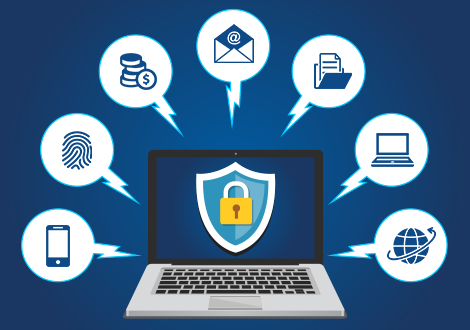
Protecting your home computer is crucial in today’s digital age, where cyber threats and malware are prevalent. Ensuring your computer’s security not only safeguards your personal data but also protects you from various online threats. In this blog post, we’ll discuss essential tips and best practices to keep your home computer safe and secure.
Table of Contents
Toggle1. Install and Maintain Antivirus Software
Choose Reliable Antivirus Software
Installing antivirus software is one of the first steps in protecting your computer. Choose reputable antivirus programs from trusted providers, such as Norton, McAfee, or Bitdefender. These programs offer real-time protection against viruses, malware, and other malicious threats.
Keep Software Updated
Ensure that your antivirus software is always up-to-date. Regular updates include the latest virus definitions and security patches, helping your software detect and neutralize new threats. Most antivirus programs offer automatic updates, so enable this feature to stay protected.
2. Use a Firewall
Enable Your Computer’s Firewall
A firewall acts as a barrier between your computer and potential threats from the internet. Most operating systems come with built-in firewalls, such as Windows Firewall or macOS Firewall. Ensure that your firewall is enabled and properly configured to monitor and block suspicious activity.
Consider a Hardware Firewall
For an additional layer of protection, consider using a hardware firewall. This device sits between your computer and your internet connection, providing an extra layer of security against cyber threats. Hardware firewalls are particularly useful for households with multiple devices.
Know more about: Mississippi Secretary Of State
3. Update Your Operating System and Software
Keep Your Operating System Updated
Regular updates to your operating system (OS) are crucial for maintaining security. Updates often include security patches and bug fixes that address vulnerabilities. Enable automatic updates to ensure you receive the latest security fixes promptly.
Update All Installed Software
In addition to your OS, keep all installed software up-to-date. This includes web browsers, office applications, and other programs. Software developers regularly release updates to fix security flaws, so install these updates as soon as they become available.
4. Use Strong and Unique Passwords
Create Strong Passwords
Strong passwords are essential for protecting your accounts and data. Create passwords that are at least 12 characters long and include a mix of uppercase letters, lowercase letters, numbers, and special characters. Avoid using easily guessable information, such as names or birthdates.
Use a Password Manager
Managing multiple strong passwords can be challenging. Consider using a password manager to securely store and manage your passwords. Password managers can generate strong passwords, autofill login forms, and securely store sensitive information.
5. Be Cautious with Email and Links
Avoid Phishing Scams
Phishing scams are attempts to steal personal information by pretending to be a trustworthy source. Be cautious with email attachments and links from unknown or unexpected sources. Verify the sender’s identity before clicking on any links or opening attachments.
Verify URLs
Before entering sensitive information on a website, check the URL to ensure it’s legitimate. Look for “https” in the URL and a padlock icon in the address bar, indicating that the website uses a secure connection.
6. Backup Your Data Regularly
Use Backup Solutions
Regular backups are essential for protecting your data from loss due to hardware failure, malware, or other issues. Use backup solutions such as external hard drives, cloud storage services, or both to ensure that your data is safely stored and easily recoverable.
Schedule Automatic Backups
To ensure that your data is consistently backed up, schedule automatic backups. Most backup software and cloud storage services offer options to automate the backup process, making it easier to maintain up-to-date copies of your important files.
7. Secure Your Home Network
Change Default Router Settings
Securing your home network starts with changing the default settings on your router. Change the default username and password for accessing your router’s settings to prevent unauthorized access. Additionally, update your router’s firmware regularly to patch any security vulnerabilities.
Use Strong Wi-Fi Encryption
Enable WPA3 (Wi-Fi Protected Access 3) or WPA2 encryption on your wireless network to protect it from unauthorized access. Use a strong Wi-Fi password that is difficult to guess and avoid using common or default passwords.
Disable WPS
Wi-Fi Protected Setup (WPS) can be a security risk, as it may be vulnerable to attacks. If you’re not using WPS, consider disabling it on your router to enhance your network’s security.
8. Practice Safe Browsing Habits
Avoid Suspicious Websites
Be cautious when visiting websites, especially those that seem suspicious or untrustworthy. Avoid downloading software from unfamiliar sites and refrain from visiting sites that offer free or pirated software, as they may contain malware.
Enable Browser Security Features
Modern web browsers offer various security features, such as pop-up blockers, phishing protection, and privacy settings. Enable these features to enhance your browsing security and reduce the risk of encountering malicious content.
9. Educate Yourself and Your Family
Stay Informed About Cyber Threats
Stay informed about the latest cyber threats and security best practices. Follow reputable sources of information, such as cybersecurity blogs or official government advisories, to stay up-to-date on emerging threats and security measures.
Educate Your Family
Ensure that all members of your household are aware of basic cybersecurity practices. Educate them about the importance of strong passwords, safe browsing habits, and recognizing phishing attempts to help maintain overall security.
10. Monitor Your System for Suspicious Activity
Use Security Software with Monitoring Features
Many security software solutions offer monitoring features that detect unusual activity or potential threats. Enable these features to receive alerts about suspicious behavior and take appropriate action to address any issues.
Regularly Review Security Settings
Periodically review your computer’s security settings and configurations to ensure they are still effective. Make adjustments as needed to address new threats or changes in your security requirements.
Conclusion
Protecting your home computer is essential for safeguarding your personal information and ensuring a safe digital experience. By following these best practices—such as installing and maintaining antivirus software, using strong passwords, securing your home network, and practicing safe browsing habits—you can significantly reduce the risk of cyber threats and keep your computer secure. Staying vigilant and informed about the latest security trends will help you maintain a robust defense against potential threats and protect your valuable data.




